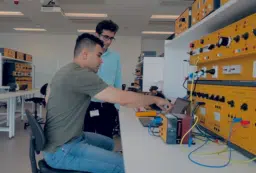From June next year, a “smart” radar system will provide Australia with a clearer picture of the movements of aircraft and shipping more than 1500 kilometres off shore.
Researchers at the Defence Science and Technology Organisation in Edinburgh north of Adelaide have developed better ways of filtering out interference to Australia’s innovative over-the-horizon radar surveillance systems. The new technology automatically adjusts how incoming radar signals are processed according to the changing conditions of interference.
“Interference can arise from lightning discharges as well as human sources, such as electrical machinery and radio stations. It often arrives from unexpected directions and can change rapidly, masking the presence of targets of interest,” says electronic engineer Joe Fabrizio, who helped design the new filter system. “To uncover these hidden targets, it is necessary to tailor the signal processing to suit the interference conditions at hand.”
The new technology learns about the characteristics of the interference from the data received, and then “teaches” the radar the best way to cancel the interference. The adaptations can be made in fractions of a second, and have worked well enough under test conditions for US researchers to be interested in applying the system to their over-the-horizon systems.
Such techniques have become feasible because of advances in computer technology, says Fabrizio. They can also be used in airborne radar systems.
He is one of sixteen young scientists presenting their discoveries to the media, public and students for the first time, at Fresh Science.
“We’ve selected them from 105 national nominations, brought them to Melbourne, trained them and thrown them to the [media] lions,” said Niall Byrne, Chairman of Fresh Science. “It’s all about focussing public and media attention on Australian scientific achievement.”




 Fresh Science is on hold for 2022. We will be back in 2023.
Fresh Science is on hold for 2022. We will be back in 2023.
Post your comments